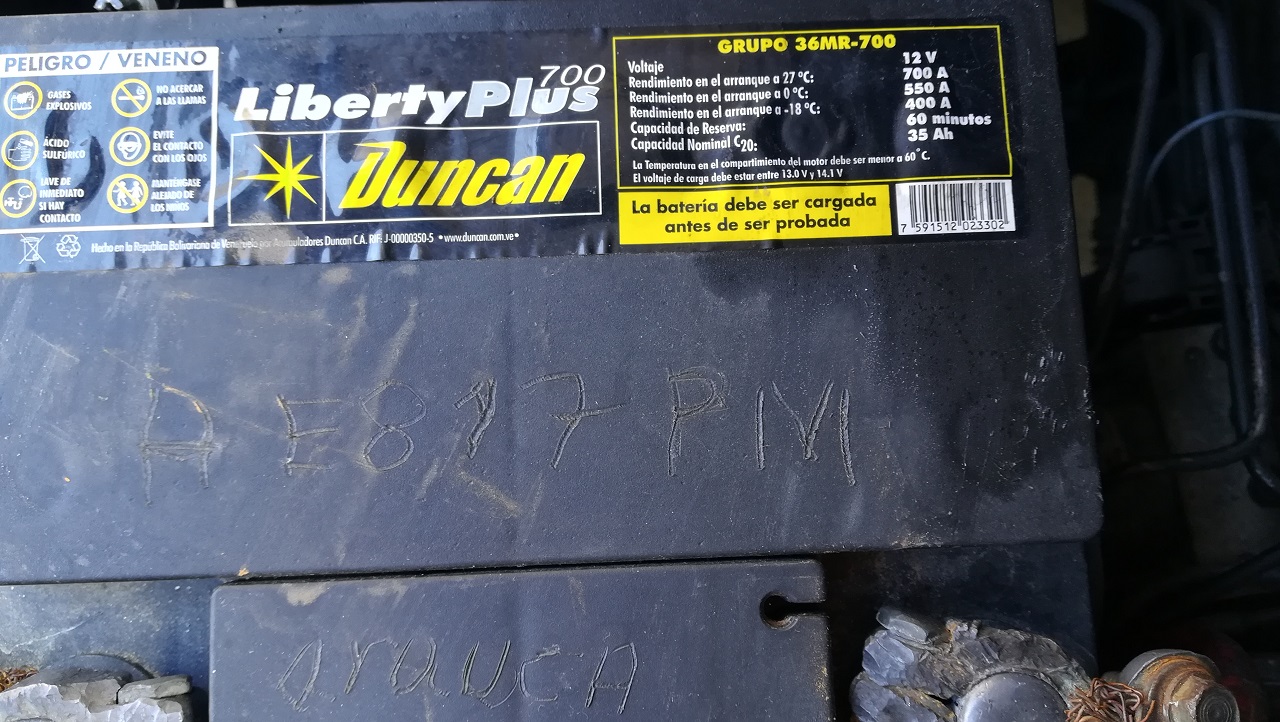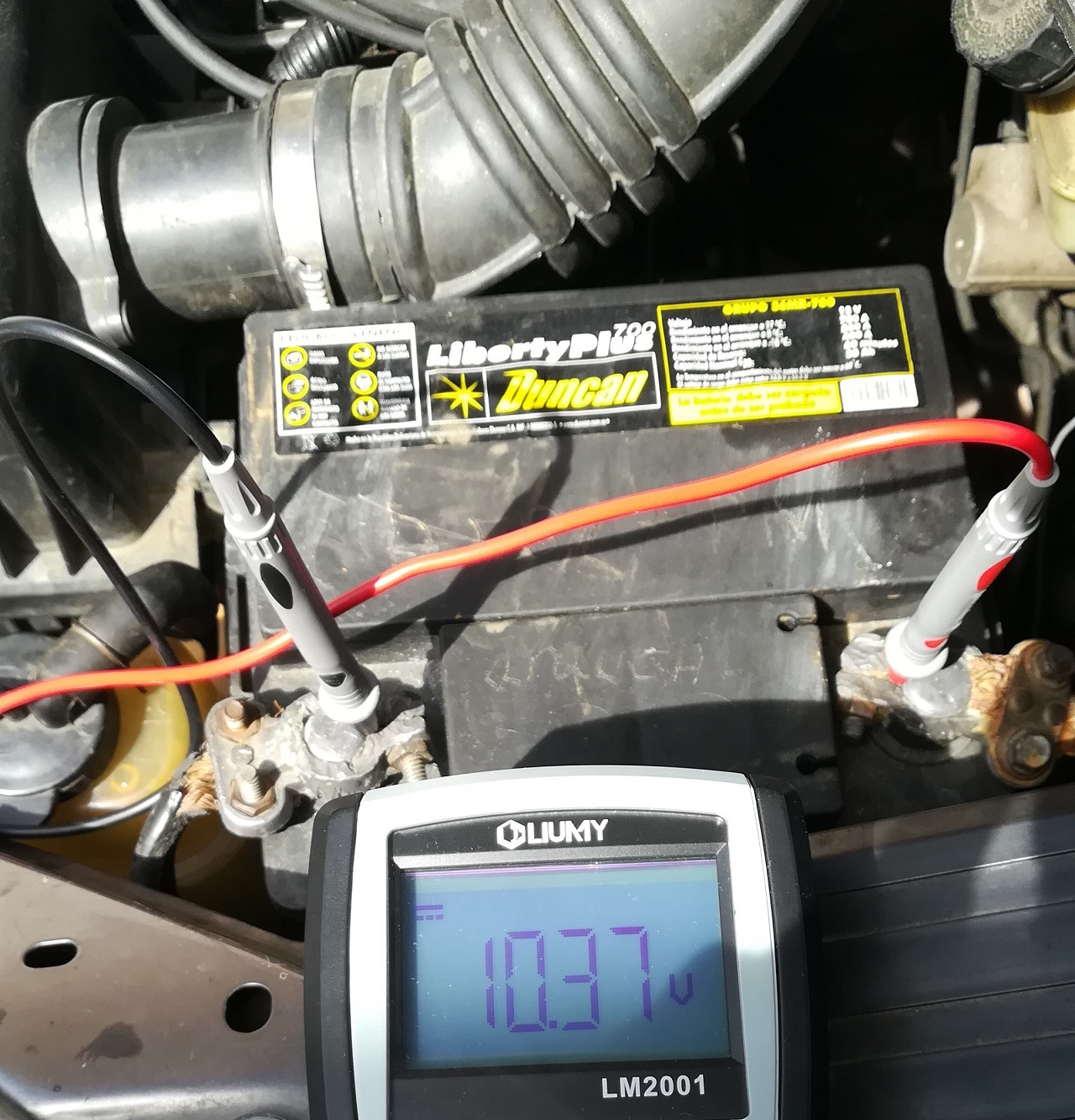Es muy probable que no pensemos en el tamaño o la potencia del motor de arranque de nuestro carro cuando necesitemos comprar una batería nueva. Probablemente nos limitamos a decir que necesitamos una batería de 12 V y 750 A o simplemente damos la marca y el modelo del auto o el número de pieza o el modelo de la batería y confiamos en que el vendedor nos indique la correcta. ¿Y si viene con una que probablemente se adecue, ya que puede tener las mismas características o clasificaciones que la nuestra, pero puede tener dimensiones diferentes, por ejemplo, simplemente porque no tiene la correcta? Debemos tener en cuenta que los vendedores ganan comisiones por sus ventas.
Here comes some questions: Do we really understand what the labels on the battery are telling us? Do we really know what those numbers on those labels mean? Is the battery oversized in capacity when compared to what our car needs? Would this battery provide enough amps to the starter motor when cranking the engine? Or to the rest of the accessories of the car when the charging system is demanded above its supply capability?
Algunas preguntas vienen a la mente: ¿Entendemos realmente lo que nos dicen las etiquetas de las baterias? ¿Sabemos realmente lo que significan los números de esas etiquetas? ¿Está la batería sobredimensionada en capacidad si la comparamos con lo que necesita nuestro carro? ¿Proporcionará esta batería suficientes amperios al motor de arranque para girar el motor? ¿O al resto de los accesorios del auto cuando el sistema de carga es exigido por encima de su capacidad de suministro?

Before entering on the meaning of those ratings, let us understand what the battery is there for. Its primary purpose is to store the energy needed to crank the engine or start the car. A secondary purpose of the battery is to act as a reservoir when electrical demands exceed that of the charging system.
We may find on the battery label, ratings such as: CCA, CA, AH, and RC. What are they telling us?
Cold Cranking Amps, CCA. It is a measurement of the number of amps that the battery can supply at 0°F (-18°C) for 30 seconds, without the voltage falling below 7.2 volts.
Cranking Amps, CA. Cranking Amps is a very similar rating to CCA, except that this test is performed at 32°F (0°C).
Amp-Hours AH. It is an indication of the number of amps the battery can deliver and for how many hours. If it was, say, 50 AH, it could very well mean that it could deliver 50 amps for one hour, or probably 25 amps for 2 hours, or even 10 amps for 5 hours, depending on every vehicle needs.
Reserve Capacity, RC. Is the time, in minutes, that the battery may supply 25 amps while maintaining a voltage above 10.5 volts. In fact, this represents the time in minutes that a car could continue to be driven if the charging system fails.
Antes de entrar en lo que significan esas caracteristicas, entendamos para qué sirve la batería. Su propósito principal es almacenar la energía necesaria para arrancar el motor del auto. Un segundo propósito de la batería es actuar como depósito cuando las demandas eléctricas superan las del sistema de carga.
En la batería podemos encontrar etiquetas con: CCA, CA, AH y RC. ¿Qué nos dicen?
Amperios de arranque en frío, CCA. Es una medida del número de amperios que la batería puede suministrar a 0°F (-18°C) durante 30 segundos, sin que la tensión caiga por debajo de 7,2 voltios.
Amperios de arranque, CA. Los amperios de arranque son una clasificación muy similar a la CCA, excepto que esta prueba se realiza a 32 °F (0 °C).
Amperios-hora AH. Es una indicación del número de amperios que la batería puede suministrar y durante cuántas horas. Si fuera, por ejemplo, 50 AH, podría significar perfectamente que puede entregar 50 amperios durante una hora, o probablemente 25 amperios durante 2 horas, o incluso 10 amperios durante 5 horas, dependiendo de las necesidades de cada vehículo.
Capacidad de reserva, RC. Es el tiempo, en minutos, que la batería puede suministrar 25 amperios manteniendo una tensión superior a 10,5 voltios. De hecho, representa el tiempo en minutos que un coche podría seguir circulando si el sistema de carga falla.

source
Having talked about the battery, let us think for a minute about the starting motor’s needs the battery must supply.
As a thumb rule, for every cubic centimeter of compression, the current supply should fall between 0.10 to 0.15 amps. So, for a 1.3 lt engine, the current needed by the starter motor to do its job lies between 130 to 195 amps.
Habiendo hablado de la batería, pensemos por un momento en las necesidades del motor de arranque que la batería debe suministrar.
Como regla general, por cada centímetro cúbico de compresión, el suministro de corriente debe oscilar entre 0,10 y 0,15 amperios. Así, para un motor de 1,3 lt, la corriente que necesita el motor de arranque para hacer su trabajo se sitúa entre 130 y 195 amperios.
That was precisely the idea I was trying to convey in my introductory lines in this post. For a starter motor to turn the crankshaft and everything attached to this shaft, it must have sufficient power at 12.6 volts, to provide the necessary torque. Generally speaking, the power of a starting motor goes from 1.5 to 2.5 kw for a small engine. Applying Ohm’s Law, this means that the current it requires, goes from 125 to 208 amp. This range of value is similar to the one in the previous paragraph.
Esta era precisamente la idea que intentaba transmitir en mis líneas introductorias de este post. Para que un motor de arranque haga girar el cigüeñal y todo lo que está conectado a este, debe tener una potencia suficiente a 12,6 voltios, para proporcionar el par necesario. En general, la potencia de un motor de arranque va de 1,5 a 2,5 kw para un motor pequeño. Aplicando la Ley de Ohm, esto significa que la corriente que requiere, va de 125 a 208 amperios. Este rango de valores es similar al del párrafo anterior.
However, how do we know our car’s battery is in good conditions to supply this current? For that let us do the following test:
-. Place the leads of a multimeter on the battery terminals.
-. Measure the battery voltage. It should be 12.5 V minimum.
Sin embargo, ¿cómo sabemos que la batería de nuestro vehiculo está en buenas condiciones para suministrar esta corriente? Para ello hagamos la siguiente prueba:
-. Colocar los cables de un multímetro en los bornes de la batería.
-. Medir la tensión de la batería. Debe ser de 12,5 V como mínimo.

-. Disconnect the relay that feeds voltage to the fuel pump to disable it.
-. Turn the key to ignition to crank the engine.
.- Observe the value the voltage of the battery drops to. It should not fall below 9.5 V.
-. Desconecte el relé que alimenta de tensión a la bomba de combustible para desactivarla.
-. Gire la llave de ignición para arrancar el motor.
-. Observe el valor minimo al que cae la tensión de la batería. No debe estar por debajo de 9,5 V.

Modern cars need this value or a higher one because the computers on board, especially the engine’s computer, has a threshold of about 9.5 V. So, if the battery voltage drops below this value, pulses to the fuel injectors will not be supplied.
In normal conditions, with an engine running, a multimeter should read about 13.5 at idle. This would tell, the charging system is doing that what it is meant for.
Los autos modernos necesitan un valor similar o superior porque los ECU o computadores abordo, especialmente el del motor, tienen un umbral de unos 9,5 V. Por lo tanto, si la tensión de la batería cae por debajo de este valor, los inyectores de combustible no recibiran los pulsos para el suministro de combustible.
En condiciones normales, con el motor en marcha, un multímetro debería leer alrededor de 13,5 en ralentí. Esto indicaría que el sistema de carga está haciendo lo que tiene que hacer.

So, before purchasing a battery, perform this test and make sure the battery needs replacement
On the other hand, if it does not pass the test, having checked the charging system is working well, then a new battery is needed.
As a summary, if we understand that the CCA is the amps to start the engine without the voltage falling below 9.5 V or 7.2 V for that matter, and this rating is well over what is needed by the starting motor to crank it, it means the battery the salesman is offering, is good enough for our car.
Por lo tanto, antes de comprar una batería, realice esta prueba y asegúrese de que la batería necesita ser reemplazada
Por otro lado, si no pasa la prueba, habiendo comprobado que el sistema de carga funciona bien, entonces necesita una nueva batería.
Como resumen, si entendemos que la CCA son los amperios para arrancar el motor sin que el voltaje caiga por debajo de 9,5 V o 7,2 V para el caso, y este valor está muy por encima de lo que necesita el arranque para girar el motor, significa que la batería que el vendedor está ofreciendo, es lo suficientemente buena para nuestro vehiculo.

Congratulations @ogutierrez! You have completed the following achievement on the Hive blockchain and have been rewarded with new badge(s):
Your next target is to reach 700 upvotes.
You can view your badges on your board and compare yourself to others in the Ranking
If you no longer want to receive notifications, reply to this comment with the word
STOPCheck out the last post from @hivebuzz:
Hola, en mi opinión ha sido una publicación ejemplar, redactada con empeño, cuidada en cada aspecto y la has rematado con un gif de primera calidad, sin duda una publicación muy bien elaborada.
Hola que tal. Agradecido por tu opinion. La intención es transmitir algo de lo aprendido de la mejor manera posible.
Que estes bien
Gracias, igualmente :)